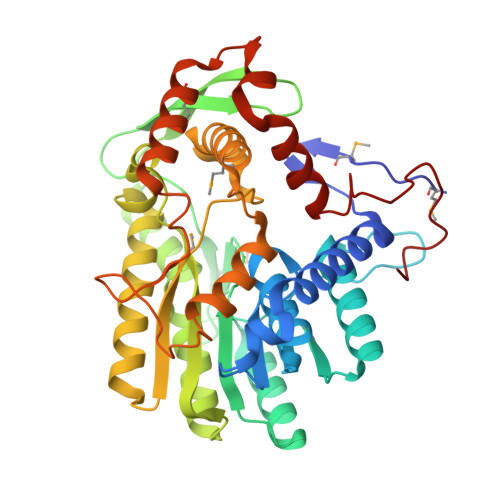Biochemical and Structural Characterization of the trans-Enoyl-CoA Reductase from Treponema denticola.
Bond-Watts, B.B., Weeks, A.M., Chang, M.C.(2012) Biochemistry 51: 6827-6837
- PubMed: 22906002
- DOI: https://doi.org/10.1021/bi300879n
- Primary Citation of Related Structures:
4GGO, 4GGP - PubMed Abstract:
The production of fatty acids is an important cellular pathway for both cellular function and the development of engineered pathways for the synthesis of advanced biofuels. Despite the conserved reaction chemistry of various fatty acid synthase systems, the individual isozymes that catalyze these steps are quite diverse in their structural and biochemical features and are important for controlling differences at the cellular level. One of the key steps in the fatty acid elongation cycle is the enoyl-ACP (CoA) reductase function that drives the equilibrium forward toward chain extension. In this work, we report the structural and biochemical characterization of the trans-enoyl-CoA reductase from Treponema denticola (tdTer), which has been utilized for the engineering of synthetic biofuel pathways with an order of magnitude increase in product titers compared to those of pathways constructed with other enoyl-CoA reductase components. The crystal structure of tdTer was determined to 2.00 Å resolution and shows that the Ter enzymes are distinct from members of the FabI, FabK, and FabL families but are highly similar to members of the FabV family. Further biochemical studies show that tdTer uses an ordered bi-bi mechanism initiated by binding of the NADH redox cofactor, which is consistent with the behavior of other enoyl-ACP (CoA) reductases. Mutagenesis of the substrate binding loop, characterization of enzyme activity with respect to crotonyl-CoA, hexenoyl-CoA, and dodecenoyl-CoA substrates, and product inhibition by lauroyl-CoA suggest that this region is important for controlling chain length specificity, with the major portal playing a more important role for longer chain length substrates.
Organizational Affiliation:
Department of Chemistry, University of California, Berkeley, CA 94720-1460, USA.















